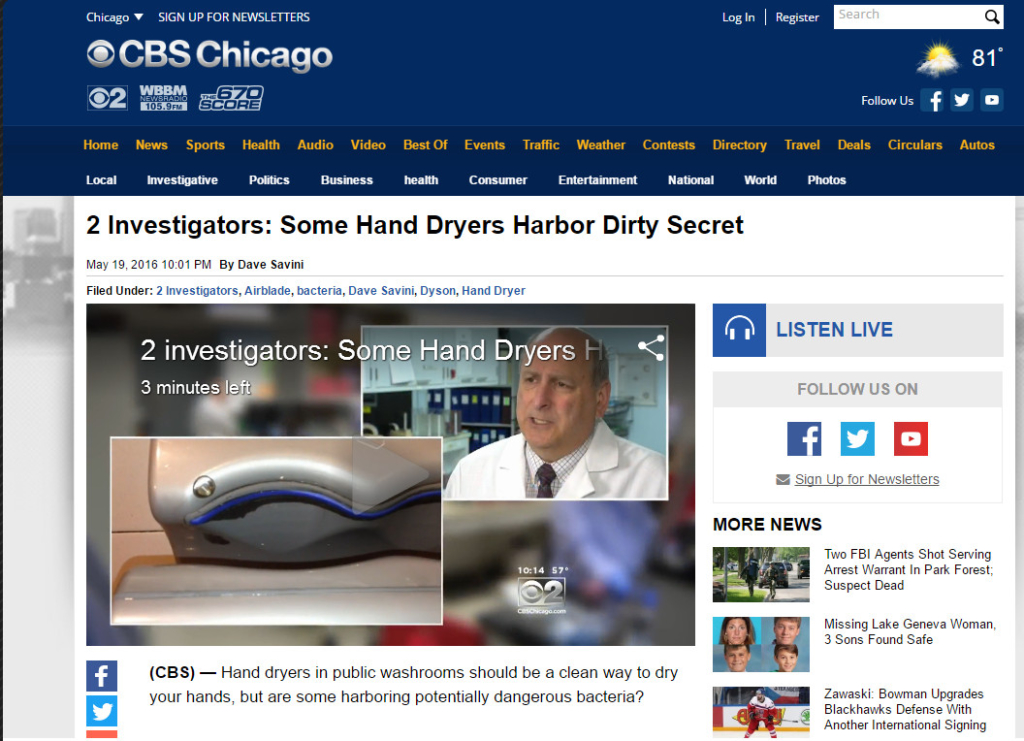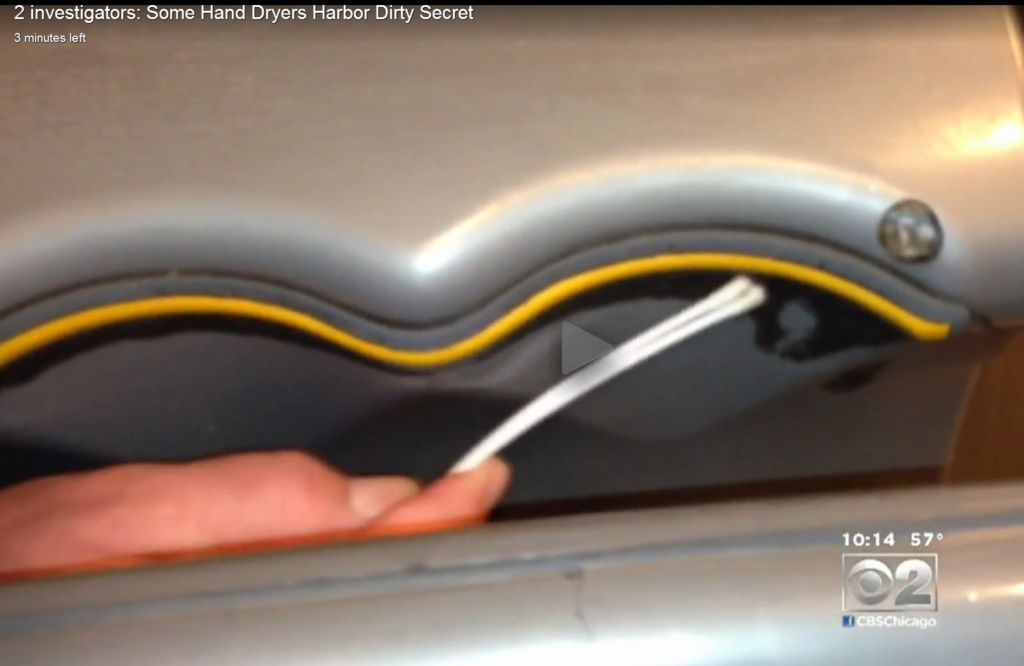2 Investigators: Some Hand Dryers Harbor Dirty Secret
May 19, 2016 10:01 PM By Dave Savini
A very interesting article has appeared on May 19, 2016 in the Blackdailynews section of the CBS website. To read the full article, please use the following link: http://chicago.cbslocal.com/2016/05/19/2-investigators-hand-dryer-harbors-dirty-secret/
Here are reproduced some images and passages of the article.
(CBS) — Hand dryers in public washrooms should be a clean way to dry your hands, but are some harboring potentially dangerous bacteria?
CBS 2’s Dave Savini tested filthy-looking hand dryers.
The CBS 2 Investigators scraped, swabbed and collected grime from 12 Dyson Airblade hand dryers in the Chicago area, following the guidance and protocol set by Loyola University Medical Center’s microbiology lab.
Dr. Paul Schreckenberger and researcher Sam Collier conducted the lab tests. They found potentially harmful bacteria in most of the ones tested.


“Ten out of the 12 were grossly contaminated,” Collier says.
The 10 dirtiest machines tested were at Glenview’s Costco, the Glen of North Glenview and Union Station train stations, Fox Valley Mall, Water Tower Place and Whole Foods in Naperville.
Three more bathrooms at the Rosemont outlet mall, called Fashion Outlets of Chicago, all tested positive for large bacteria colonies.
“Very significant growth,” Collier says. “Greater than 100,000 colonies.”
Loyola University Medical Center infectious disease expert Andrew Bonwit reviewed the results. He says the lab tests revealed, among other things, two pathogens that could lead to infections: Klebsiella oxytoca and Enterobacter cloacae.
“They have the potential to be serious infections in a broader variety of people,” Bonwit says.
Klebsiella oxytoca can be found in fecal matter and can be even more harmful to those with compromised immune systems, he says.
“If you have cuts or abrasions and you get more organisms on those abrasions, you might get an infection in the skin,” Bonwit says.
Eight machines that were tested contained one or two of those human pathogens. These included two machines at Union Station and two at the Rosemont outlets; also the Glen of North Glenview station, Whole Foods, Water Tower Place and Fox Valley Mall.
Again following Loyola University Medical Center’s lab protocol, CBS 2 also tested hands that had been washed and then tested them again after drying. Half of those tests showed hands were dirtier after they were dried in the machines.
“These hand dryers are not sanitized. They are not clean, and they have the potential of putting bacteria back on your hands after we’ve dried them,” Schreckenberger says.
In fact, the Fox Valley Mall testing showed Klebsiella oxytoca on the machine and on a hand that did not have it until after it was dried.
Some companies have started getting rid of these hand dryers. Advocate Lutheran General Hospital officials say they had to remove about 20 of them because they were just too hard to keep clean.
For similar reasons, officials from Fox Valley Mall say they are also removing them.
Comments about the study described in the CBS article:
Mark Wilcox, Head of Microbiology and Academic Lead of Pathology at the Leeds Teaching Hospitals (LTHT) and Professor of Medical Microbiology at the University of Leeds (Leeds Institute of Molecular Medicine), UK, made the following comment about the study:
“The results of testing jet air hand dryers, according to methods recommended by Loyola University Medical Center’s microbiology laboratory, that are shown in the CBS report are disturbing. However, the high levels of bacterial contamination of these hand dryers are not surprising, and indeed the findings are consistent with other published and independently reviewed studies, including our own. Jet air dryers work by shearing the water droplets from hands; these water droplets will be contaminated with microbes, including potentially harmful bacteria, particularly when the hands have been poorly washed. The water droplets with microbes inside are splattered onto the air dryers, eventually causing high levels of contamination, especially if these are not maintained properly, as shown in the CBS report. Notably, we have shown that the same water and microbe splattering effect contaminates the hand dryer user, others in the washroom, and the surfaces of the washroom. Jet air dryers are good at drying hands, but achieve this at the cost of increasing microbe contamination compared with hand drying using paper towels.”
More about the latest study of Mark Wilcox at the page: “http://europeantissue.com/hygiene/studies/potentialcontaminationenvironment2014/”
In addition Keith Redway, Emeritus Fellow at the University of Westmenster, UK, stated: “It is helpful to know that other researchers have also found the same bacteria of faecal origin, amongst others, that we at the University of Westminster found in a previous study sampling jet air dryers in public washrooms in London.
This new study confirms our one.
It is interesting to know that others also have concerns about the hygiene of these devices.”
In a personal communication from the Loyola University to Keith Redway:
Good Afternoon Mr. Redway,
We appreciate you reaching out to us. I had a chance to look over the results from your study. The organisms you folks isolated were strikingly similar to ours. Below is an overview of the protocol we used.
Swabs were collected at 12 different locations in the downtown/greater Chicago area (3 swabs were collected at each location).
Swab 1: Researcher swabs the freshly washed hands of the study subject (hands still wet).
Swab 2: Researcher swabs the hands of the study subject immediately after the subject has dried his/her hands in the jet hand-dryer.
Swab 3: Researcher swabs the jet hand-dryer machine (within the hand drying area).
*the study subject’s palms, fingers and back of hands were swiped for each swab
Once the swabs were collected, they were brought to our lab. Each swab was placed into an inoculum tube filled with 1mL of sterile saline and vortexed. The inoculum for each swab was then plated to 1 Blood agar plate and 1 MacConkey plate for Quantitative cultures. Organisms were identified using Bruker MALDI-TOF mass spectrometry.
You can read more about Keith Redway’s 2008 study Part D: Bacterial sampling of jet air dryers in public washrooms at the following link: http://europeantissue.com/pdfs/090402-2008%20WUS%20Westminster%20University%20hygiene%20study,%20nov2008.pdf) on the ETS website
In addition, you can learn about the latest study of Keith Redway at the page: “http://europeantissue.com/hygiene/studies/hand-dryingsingleuse-towels/“
In the page: Hygiene related studies, you can also find links to other independent studies (TUV Germany 2005 and 2011 studies, Mayo Clinic Proceedings 2012) which reach very similar conclusions.











